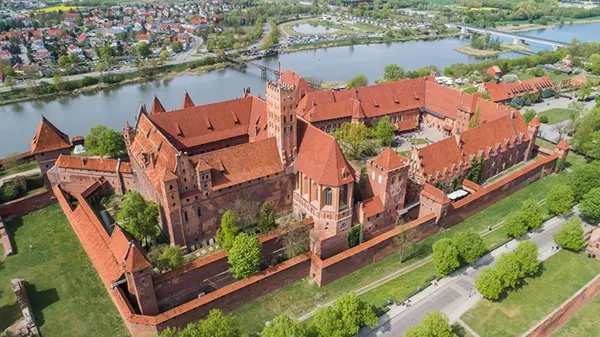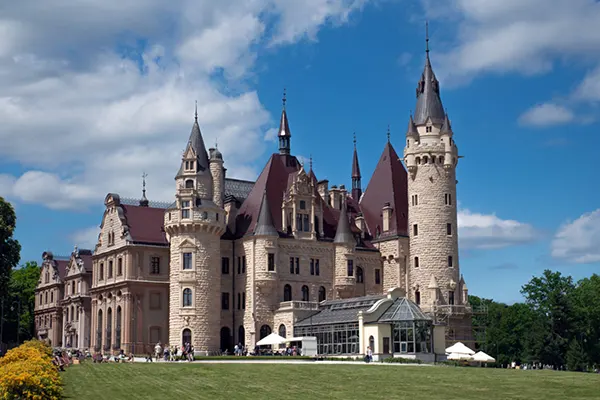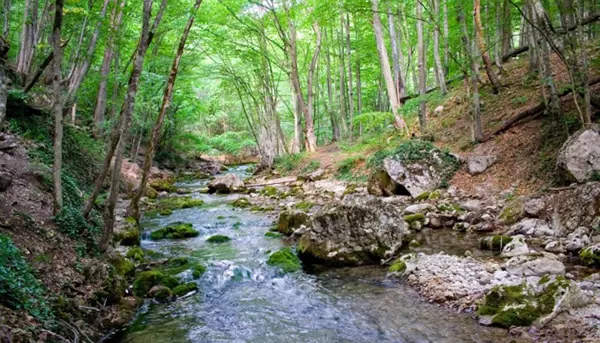
Zamek Czocha: The Polish Hogwarts in Lower Silesia
Perched on a rocky hill near the Leśniańskie Lake, Zamek Czocha is a captivating Gothic fortress in Lower Silesia, Poland. Built in the 13th century and later transformed into a Renaissance residence, it combines architectural grandeur with a mysterious past. While it may not be as famous as other Polish landmarks, its atmosphere, legends and modern role in pop culture make it one of the most unique castles in Central Europe.
The Origins and Historical Significance of Zamek Czocha
Originally constructed as a defensive stronghold in 1247 on the orders of Czech King Wenceslaus I, Zamek Czocha played a vital role in the regional disputes of Silesia and Bohemia. Over centuries, it changed hands among noble families, survived invasions, and underwent significant renovations, especially in the 17th and 18th centuries. Its current structure reflects a fusion of medieval Gothic and later Baroque influences.
In the 20th century, the castle was heavily damaged during World War II. After the war, it was confiscated by the Polish state and repurposed for various military uses, including as a secret communication centre for the Polish army. It wasn’t until the early 1990s that the building was reopened to the public, following a restoration effort that revealed many of its hidden chambers and passageways.
Today, Zamek Czocha is not only a symbol of historical resilience but also a preserved monument that reflects the cultural shifts of the region. Its documentation includes secret compartments, misleading doors, and structural oddities that suggest it was used for espionage or covert military operations.
Myths and Legends Surrounding the Castle
What truly sets Zamek Czocha apart are the local myths that swirl around its towers and halls. Perhaps the most famous is the tale of the ‘Well of Unfaithful Wives,’ where it’s said that adulterous women were thrown after their secrets were revealed. The legend, though grim, adds to the castle’s Gothic allure and has become part of local lore passed through generations.
Another widely told story is that of a haunted chamber said to be visited by the ghost of a woman clad in white – possibly a victim of one of the castle’s medieval punishments. Visitors and staff have reported strange noises, flickering lights, and cold drafts in certain areas of the structure, contributing to its reputation as a paranormal hotspot.
Lastly, the labyrinthine architecture has fuelled speculation that the castle was built with concealment in mind. Many believe that it contains still-undiscovered hidden rooms, and treasure hunters occasionally petition for permission to explore sealed-off sections. This blend of history and folklore continues to attract enthusiasts of the arcane.
Filming Location for Fantasy and Historical Productions
In recent decades, Zamek Czocha has gained popularity as a cinematic location, often compared to Hogwarts from the Harry Potter series due to its dramatic profile and eerie charm. While it was not used in the actual films, its interiors and facade have featured in numerous Polish and international productions.
Movies such as “The Hexer” (Wiedźmin) and series like “Sensacje XX Wieku” used the castle’s naturally atmospheric backdrops to depict medieval and fantasy worlds. The castle’s preserved rooms, antique furniture, and dimly lit stone corridors require little set dressing to feel like a scene from an epic saga.
Production crews are drawn to Zamek Czocha not only for its visuals but for its authenticity. Unlike modernised museums, the castle retains a raw, lived-in quality, which makes it ideal for immersive storytelling. Directors often cite its versatility—capable of representing various European eras—as a major benefit for historical reenactments and period films.
Live Action Role-Playing (LARP) and Themed Events
One of the more recent trends revitalising the castle’s appeal is its hosting of LARP events, where participants immerse themselves in fantastical narratives within the medieval setting. These games, often themed around witchcraft, chivalry or espionage, attract enthusiasts from across Europe who appreciate the castle’s theatrical backdrop.
Organisers transform the castle into a live-action fantasy world, using its architecture as part of the gameplay. Secret doors become escape routes; dungeons become interrogation rooms. The setting enhances the realism and elevates the participant experience beyond conventional entertainment venues.
These events also boost cultural tourism and give new life to the castle’s heritage. Many who attend return for historical tours, thus helping to sustain the monument through creative reuse and community engagement.

Tourist Experience and Educational Programmes
Visitors to Zamek Czocha are greeted with a wide range of programmes tailored for history enthusiasts, students, and even casual travellers. Guided daytime tours highlight the castle’s defensive features, legends, and architectural details, often with local historians providing context in several languages.
However, it is the night tours that have gained particular renown. Lit by torches and accompanied by costumed guides, these excursions explore the more mysterious elements of the castle, including its hidden staircases, torture chambers, and ghost stories. It’s a popular choice for those seeking a deeper, more atmospheric experience.
For schools and cultural groups, the castle offers educational workshops that include medieval calligraphy, sword-fighting demonstrations, and lectures on espionage in Cold War Poland. These programmes aim to blend learning with engagement, offering tangible interaction with Polish history.
Accommodation and Special Events
Uniquely, Zamek Czocha also functions as a hotel, allowing guests to spend the night within its storied walls. Rooms are decorated with antique furnishings that echo the castle’s historical periods, offering an immersive experience for overnight visitors.
The castle frequently hosts themed weekends, such as Renaissance fairs, mystery dinners, or historical reenactments. These attract not only tourists but also local communities, reinforcing the site’s position as both a cultural landmark and a social venue.
Weddings, conferences and photography workshops are also held on the premises. Whether you’re seeking a unique venue or simply a journey into history, Zamek Czocha offers a range of options that extend far beyond standard sightseeing.
Popular articles
-
 Malbork Castle – The Largest Brick Fortress in the World
Malbork Castle – The Largest Brick Fortress in the WorldMalbork Castle stands as one of the most significant medieval …
-
 Moszna Castle: A Fairytale Landmark of Lower Silesia
Moszna Castle: A Fairytale Landmark of Lower SilesiaMoszna Castle stands as one of the most recognisable historical …
-
 Roztocze — the Green Pearl of Eastern Poland
Roztocze — the Green Pearl of Eastern PolandRoztocze, a scenic region stretching across the Lublin Voivodeship in …
